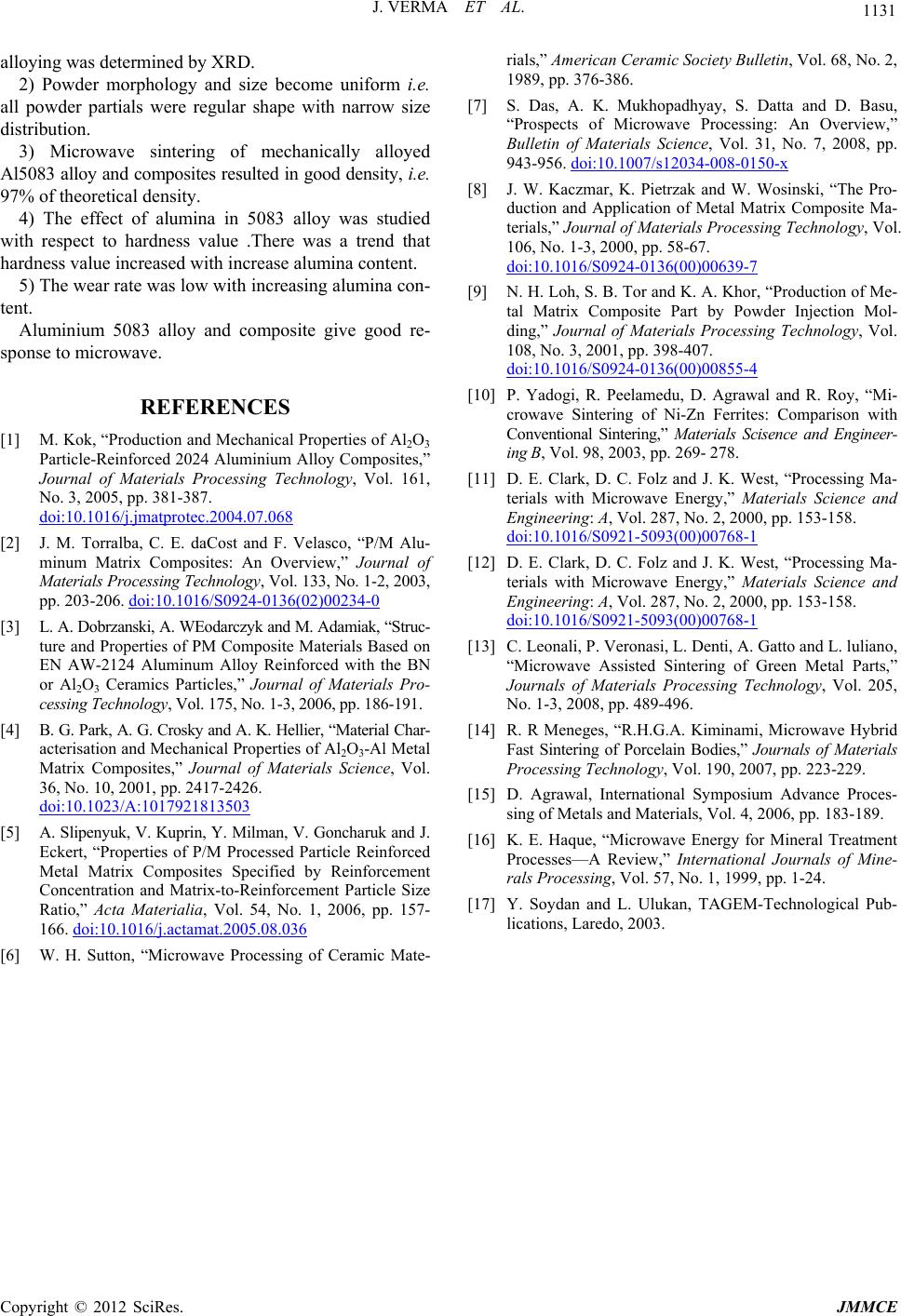
J. VERMA ET AL.
Copyright © 2012 SciRes. JMMCE
1131
alloying was determined by XRD.
2) Powder morphology and size become uniform i.e.
all powder partials were regular shape with narrow size
distribution.
3) Microwave sintering of mechanically alloyed
Al5083 alloy and composites resulted in good density, i.e.
97% of theoretical density.
4) The effect of alumina in 5083 alloy was studied
with respect to hardness value .There was a trend that
hardness value increased with increase alumina content.
5) The wear rate was low with increasing alumina con-
tent.
Aluminium 5083 alloy and composite give good re-
sponse to microwave.
REFERENCES
[1] M. Kok, “Production and Mechanical Properties of Al2O3
Particle-Reinforced 2024 Aluminium Alloy Composites,”
Journal of Materials Processing Technology, Vol. 161,
No. 3, 2005, pp. 381-387.
doi:10.1016/j.jmatprotec.2004.07.068
[2] J. M. Torralba, C. E. daCost and F. Velasco, “P/M Alu-
minum Matrix Composites: An Overview,” Journal of
Materials Processing Tech nology , Vol. 133, No. 1-2, 2003,
pp. 203-206. doi:10.1016/S0924-0136(02)00234-0
[3] L. A. Dobrzanski, A. WEodarczy k and M. Adamiak, “Str uc-
ture and Properties of PM Composite Materials Based on
EN AW-2124 Aluminum Alloy Reinforced with the BN
or Al2O3 Ceramics Particles,” Journal of Materials Pro-
cessing Technology, Vol. 175, No. 1-3, 2006, pp. 186-191.
[4] B. G. Park, A. G. Crosky and A. K. Hellier, “Material Char-
acterisation and Mechanical Properties of Al2O3-Al Metal
Matrix Composites,” Journal of Materials Science, Vol.
36, No. 10, 2001, pp. 2417-2426.
doi:10.1023/A:1017921813503
[5] A. Slipenyuk, V. Kupri n, Y. Milman, V. Goncharuk and J.
Eckert, “Properties of P/M Processed Particle Reinforced
Metal Matrix Composites Specified by Reinforcement
Concentration and Matrix-to-Reinforcement Particle Size
Ratio,” Acta Materialia, Vol. 54, No. 1, 2006, pp. 157-
166. doi:10.1016/j.actamat.2005.08.036
[6] W. H. Sutton, “Microwave Processing of Ceramic Mate-
rials,” American Ceramic Society Bulletin, Vol. 68, No. 2,
1989, pp. 376-386.
[7] S. Das, A. K. Mukhopadhyay, S. Datta and D. Basu,
“Prospects of Microwave Processing: An Overview,”
Bulletin of Materials Science, Vol. 31, No. 7, 2008, pp.
943-956. doi:10.1007/s12034-008-0150-x
[8] J. W. Kaczmar, K. Pietrzak and W. Wosinski, “The Pro-
duction and Application of Metal Matrix Composite Ma-
terials,” Journal of Materials Processing Technology, Vol.
106, No. 1-3, 2000, pp. 58-67.
doi:10.1016/S0924-0136(00)00639-7
[9] N. H. Loh, S. B. Tor and K. A. Khor, “Production of Me-
tal Matrix Composite Part by Powder Injection Mol-
ding,” Journal of Materials Processing Technology, Vol.
108, No. 3, 2001, pp. 398-407.
doi:10.1016/S0924-0136(00)00855-4
[10] P. Yadogi, R. Peelamedu, D. Agrawal and R. Roy, “Mi-
crowave Sintering of Ni-Zn Ferrites: Comparison with
Conventional Sintering,” Materials Scisence and Engineer-
ing B, Vol. 98, 2003, pp. 269- 278.
[11] D. E. Clark, D. C. Folz and J. K. West, “Processing Ma-
terials with Microwave Energy,” Materials Science and
Engineering: A, Vol. 287, No. 2, 2000, pp. 153-158.
doi:10.1016/S0921-5093(00)00768-1
[12] D. E. Clark, D. C. Folz and J. K. West, “Processing Ma-
terials with Microwave Energy,” Materials Science and
Engineering: A, Vol. 287, No. 2, 2000, pp. 153-158.
doi:10.1016/S0921-5093(00)00768-1
[13] C. Leonali, P. Veronasi, L. Denti, A. Gatto and L. luliano,
“Microwave Assisted Sintering of Green Metal Parts,”
Journals of Materials Processing Technology, Vol. 205,
No. 1-3, 2008, pp. 489-496.
[14] R. R Meneges, “R.H.G.A. Kiminami, Microwave Hybrid
Fast Sintering of Porcelain Bodies,” Journals of Materials
Processing Technology, Vol. 190, 2007, pp. 223-229.
[15] D. Agrawal, International Symposium Advance Proces-
sing of Metals and Materials, Vol. 4, 2006, pp. 183-189.
[16] K. E. Haque, “Microwave Energy for Mineral Treatment
Processes—A Review,” International Journals of Mine-
rals Processing, Vol. 57, No. 1, 1999, pp. 1-24.
[17] Y. Soydan and L. Ulukan, TAGEM-Technological Pub-
lications, Laredo, 2003.